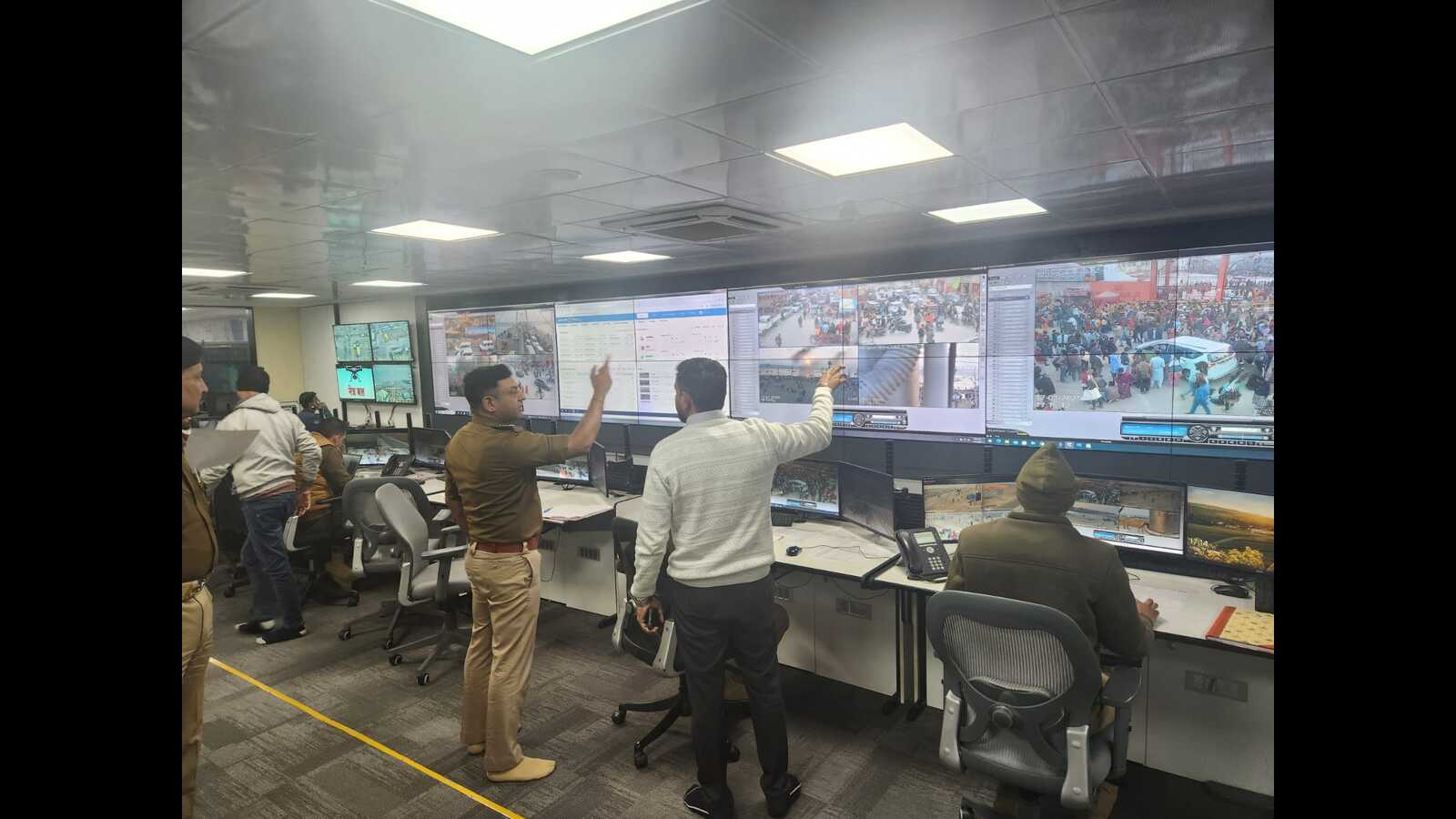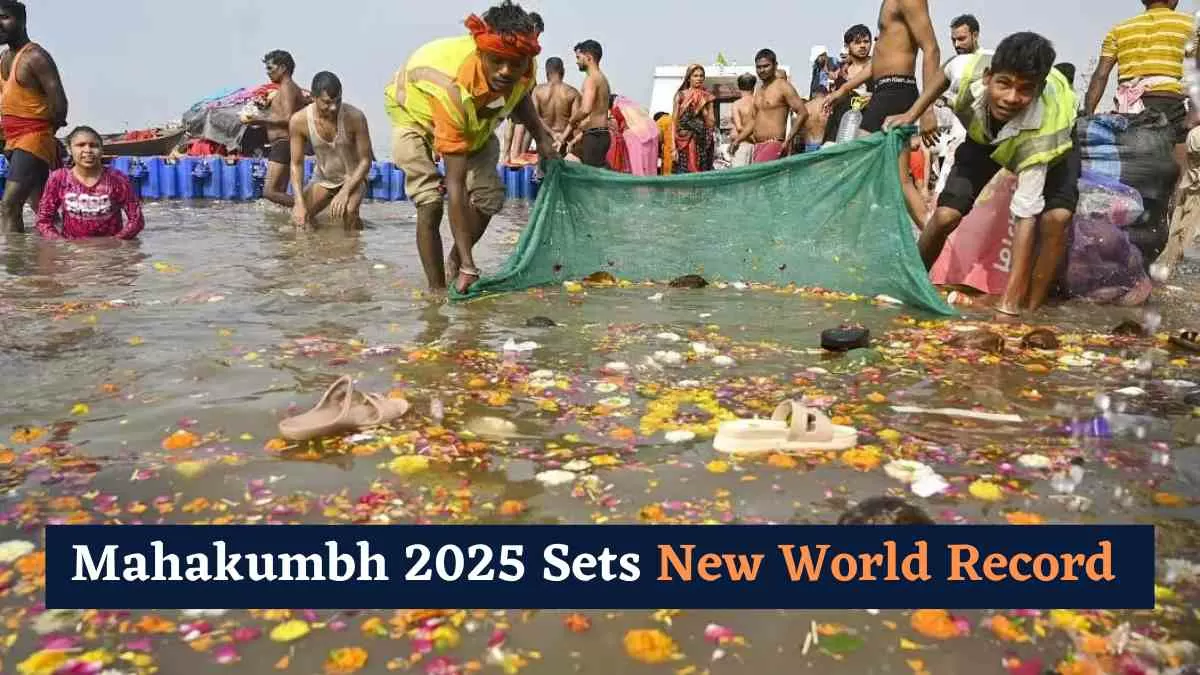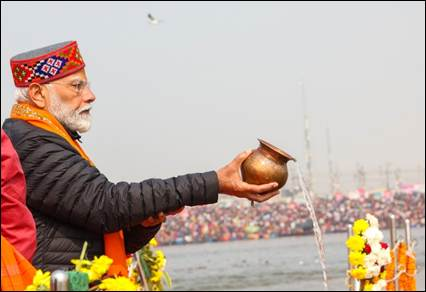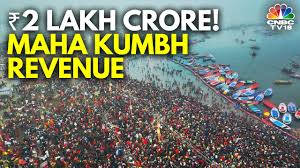The Mahakumbh 2025, which holds vast religious and cultural importance, is set to become an economic powerhouse as well. The event, which has a reported budget of ₹7,500 crore earmarked for infrastructure and logistical preparations, is expected to generate an astounding ₹2,00,000 crore in revenue. This pronounced disparity between spending and expected revenues prompts intriguing inquiries regarding the complex financial processes involved and the event's substantial economic impact.
In addition to the spiritual congregation of millions, the Mahakumbh 2025 is becoming a hub for major economic activity. The figures tell the story: a ₹7,500 crore investment designed to ease a religious pilgrimage, with expectations of generating an incredible ₹2,00,000 crore in revenue. The financial gap highlights the event's capacity to foster considerable economic development, leading to further examination of the various industries involved in this anticipated boon and its effects on the local economy.

Not only does the enormous scale of Mahakumbh 2025 become apparent through its extensive assembly of devotees, but also through its astonishing financial forecasts. The event requires a large budget of ₹7,500 crore for its organization, but estimates indicate an extraordinary revenue generation of ₹2,00,000 crore. This financial phenomenon generates curiosity and calls for a thorough investigation of the economic dynamics that underpin this enormous revenue expectation, as well as the diverse industries poised to gain from it.Breaking Down the ₹7,500 Crore Budget
1. Infrastructure Development (₹2,500 Crore)-
With the goal of revolutionizing the pilgrimage experience, an enormous investment of ₹2,500 crore was made in infrastructure development for the Mahakumbh 2025. Nonetheless, worries emerged about the possibility of unequal treatment between celebrities and ordinary people. Although the infrastructure improvements surely aided millions of pilgrims, doubts persisted regarding how resources were distributed and the degree of comfort and convenience afforded to various parts of the population. Concerns about fairness and equity were raised as reports emerged of VIP areas and exclusive access points for celebrities. Critics contended that such favoritism eroded the Mahakumbh's core values, which have always revolved around the ideas of equality and shared spiritual experience.
2. Security and Crowd Management (₹1,500 Crore)
Taking place in Prayagraj, the Maha Kumbh Mela 2025 poses an exceptional logistical challenge, as it is anticipated that around 45 crore devotees had participate throughout its 45-day period. The Uttar Pradesh government allocated ₹1,500 crore for security and crowd management to ensure the safety and smooth movement of this massive influx, deploying an impressive array of resources. This encompassed more than 50,000 police officers, paramilitary forces, and specialized units, as well as advanced technology including 2,751 CCTV cameras—328 of these equipped with AI—to observe crowd density in real time. In order to continuously monitor the vast 10,000-acre mela area, prevent overcrowding, and uphold order, drones and anti-drone systems were used along with an Integrated Command and Control Centre (ICCC).
Despite the strong security measures in place, a tragic stampede occurred on January 29, 2025, during Mauni Amavasya—one of the most auspicious bathing days—that could not be prevented. In the early morning hours, a sudden influx of pilgrims at the Sangam Nose—a constricted area—overwhelmed barricades, leading to chaos as crowds surged through and trampled those awaiting a holy dip. At least 30 people died and 60 were injured as a result of the incident, which revealed weaknesses in crowd dispersal strategies despite the available technology and personnel. According to eyewitness accounts, the scene was marked by panic and confusion as the pressure of millions of devotees arriving at once became too much to handle. The government of Uttar Pradesh acted quickly by mandating a judicial investigation and declaring a compensation of ₹25 lakh for the families of affected.
3. Cleanliness and Sanitation (₹1,000 Crore)
The 2025 Maha Kumbh Mela in Prayagraj featured an extraordinary emphasis on cleanliness and sanitation, supported by a ₹1,000 crore investment from the Uttar Pradesh government to turn the event into a hygiene model amid the tumult of 45 crore pilgrims. Thanks to this ambitious budget, more than 150,000 eco-friendly toilets—such as bio-toilets and mobile units—were deployed throughout the 10,000-acre mela area, ensuring they were accessible even in the most crowded zones. A dedicated team of 20,000 sanitation workers, aided by 300 garbage collection vehicles equipped with GPS, labored around the clock in shifts to uphold cleanliness. To promote waste segregation at source, 15,000 dustbins were put in place.
These measures proved largely effective, garnering praise from both pilgrims and observers for the visibly cleaner Maha Kumbh in comparison to past editions. With the 'Swachh Kumbh' initiative, led by Chief Minister Yogi Adityanath Ji, technology was combined with community involvement, and awareness campaigns encouraged devotees to dispose of waste properly—this represented a significant change from the litter-strewn ghats of previous years. The extensive toilet infrastructure nearly eradicated open defecation, and real-time monitoring of sanitation hotspots via drones ensured rapid responses to emerging messes.
4. Religious and Cultural Activities (₹750 Crore)
The Maha Kumbh Mela 2025 in Prayagraj turned into a vibrant celebration of faith and culture, fueled by a ₹750 crore budget that brought India’s spiritual heritage to life like never before. This massive investment transformed the 10,000-acre mela ground into a living tapestry of devotion, with over 500 majestic pavilions hosting soul-stirring performances—think Kathak dancers swaying to devotional beats, saints chanting ancient mantras, and grand reenactments of the Ramayana that left pilgrims in awe. The iconic Akhara processions, where Naga Sadhus dashed to the Sangam for their sacred dips, got a modern twist with LED-lit pathways and live drone streams, making every moment Instagram-worthy. From the Ganga Aarti’s mesmerizing glow—amped up with 1,000 trained priests—to cultural stalls serving up everything from Kumbh lore to piping-hot kachoris, this was spirituality with a human touch, pulling in 45 crore devotees to connect, celebrate, and share the vibe.
But it wasn’t just about the spectacle—₹750 crore made sure the heart of Maha Kumbh beat loud and relatable. Picture this: free Wi-Fi zones buzzing with pilgrims FaceTiming their families mid-prayer, and 50 digital kiosks dishing out real-time schedules of rituals like the Shahi Snan on February 3 (Basant Panchami). The budget roped in folk artists from across India—Rajasthani puppeteers, Bhojpuri singers, even Tamil Nadu’s Theyyam dancers—turning the mela into a viral melting pot of traditions that had X timelines flooded with #MahaKumbhMagic. Volunteers handed out eco-friendly prasad kits, while massive LED screens beamed live discourses from spiritual giants like Sadhguru and Sri Sri, making wisdom accessible to all.
5. Healthcare and Medical Facilities (₹750 Crore)
The Maha Kumbh Mela 2025 in Prayagraj prioritized the well-being of its 45 crore attendees with a robust ₹750 crore healthcare and medical facilities framework, ensuring pilgrims could immerse in spirituality without compromising their health. This hefty budget powered the creation of a sprawling medical network, including 10 fully equipped 100-bed hospitals, 25 smaller 20-bed units, and over 150 first-aid posts scattered across the 10,000-acre mela site. Staffed by 8,000 healthcare professionals—doctors, nurses, and paramedics—these facilities offered round-the-clock care, from treating minor ailments like dehydration to handling emergencies like the January 29 stampede, where rapid response teams saved countless lives. Advanced tech, like 50 telemedicine kiosks and 200 ambulances (including water ambulances along the Sangam), brought modern medicine to the masses, while 10 mobile ICUs stood ready for critical cases, making healthcare as omnipresent as the chants of “Har Har Mahadev.
Beyond infrastructure, the ₹750 crore allocation tackled the unique challenges of a mega-gathering with foresight and grit. Over 500 fogging machines and 1,000 sanitation workers curbed mosquito-borne diseases, critical during the chilly February peak, while 50,000 doses of vaccines—think flu and tetanus—were stockpiled to keep outbreaks at bay. Special attention went to vulnerable groups: elderly pilgrims got free wheelchairs, and 20 lactation centers supported mothers braving the crowds. The stampede tragedy tested this system, with 60 injured rushed to care within the golden hour, but it also highlighted gaps—some remote ghats faced delays in ambulance reach. Still, with real-time health monitoring via the ICCC and helplines buzzing in 10 languages, the Maha Kumbh’s medical backbone held strong, proving that ₹750 crore could weave a safety net as sacred as the event itself, running smoothly till February 26.
6. Branding and Promotion (₹500 Crore)
The Maha Kumbh Mela 2025 in Prayagraj wasn’t just a spiritual gathering—it became a global phenomenon, thanks to a ₹500 crore branding and promotion blitz that painted the event as the ultimate fusion of faith and modernity. This budget unleashed a multi-pronged campaign, splashing vibrant “Kumbh 2025” logos across billboards, TV ads, and social media platforms like X and Instagram, where hashtags like #MahaKumbh2025 racked up millions of impressions. A slick website and app, available in 12 languages, offered pilgrims everything from live Ganga Aarti streams to GPS-guided ghat maps, while influencers—think travel vloggers and spiritual leaders—dropped viral content, hyping the mela to a worldwide audience. International roadshows in cities like London and New York, plus glossy promo videos featuring Bollywood stars, pitched Prayagraj as a must-visit, drawing not just devotees but curious tourists to the 45-day spectacle ending February 26.
On the ground, the ₹500 crore investment turned the 10,000-acre mela into a branded wonderland that screamed accessibility and awe. Massive LED arches welcomed pilgrims with “Swagatam” messages, while 100 digital kiosks dished out schedules and trivia—did you know the Kumbh’s origins tie to a mythic nectar pot? Local artisans got a boost too, with subsidized stalls selling Kumbh-themed souvenirs—think eco-friendly diyas and saffron tees—turning devotion into a take-home vibe. Radio jingles in regional dialects and drone-shot ads of the Shahi Snan on February 3 (Basant Panchami) kept the buzz alive, though the January 29 stampede briefly shifted the narrative. Still, the campaign bounced back, with CM Yogi Adityanath’s team pushing a “Safe Kumbh” message, proving ₹500 crore could make a 45-crore-strong pilgrimage a global brand with heart, soul, and serious swagger.
7. Accommodation and Transportation (₹500 Crore)
The Maha Kumbh Mela 2025 in Prayagraj rolled out a ₹500 crore plan for accommodation and transportation, ensuring that the 45 crore pilgrims could navigate and rest comfortably across the sprawling 10,000-acre site. For lodging, the budget fueled the creation of a massive tent city, offering over 2 lakh eco-friendly tents ranging from basic shelters to deluxe setups with attached bathrooms, catering to everyone from sadhus to VIPs. These were spread across 25 designated zones, each equipped with solar-powered lights, water stations, and QR-coded entry for easy booking via the Kumbh app. Private players pitched in too, with budget hotels and homestays in Prayagraj spruced up under a government subsidy scheme, while 50,000 mattresses and blankets were stockpiled for emergencies—crucial during the chilly February nights leading up to the mela’s close on February 26.
Transportation got an equally hefty boost, knitting the chaotic influx into a smooth flow. Over 1,000 shuttle buses—many electric—crisscrossed the mela, linking key ghats like Sangam Nose to parking zones 10 kilometers out, while 200 water ferries plied the Ganga and Yamuna, shaving hours off pilgrim commutes. The budget also funded 50 temporary bus terminals and 20,000 bicycle rentals, perfect for short hops, with GPS trackers keeping tabs on traffic choke points via the ICCC. Special trains from major cities—Delhi, Mumbai, Kolkata—added 300 extra runs, and a beefed-up fleet of 5,000 auto-rickshaws kept fares capped under a “Kumbh Mitra” scheme. The January 29 stampede exposed some cracks—remote areas saw shuttle delays—but quick fixes like rerouted buses and louder signage kept the system humming, proving ₹500 crore could move and house a nation-sized crowd with grit and grace.
8.Miscellaneous Expenses (₹500 Crore)
The Maha Kumbh Mela 2025 in Prayagraj earmarked ₹500 crore for miscellaneous expenses, a catch-all fund that plugged gaps and added polish to the 45-day spectacle attended by 45 crore pilgrims. This budget covered a kaleidoscope of essentials often overlooked: think 10,000 portable power generators lighting up the 10,000-acre mela after dusk, 5,000 water ATMs dispensing free purified drinks, and a fleet of 200 misting towers to beat the dust and heat. It also bankrolled contingency measures—like rapid road repairs after heavy footfall and 1,000 extra loudspeakers blaring announcements in 10 languages—ensuring chaos didn’t derail devotion. From printing 50 lakh maps to stocking 20,000 fire extinguishers, this fund was the unsung hero keeping the mela’s pulse steady through February 26.
Beyond logistics, the ₹500 crore spiced up the human experience with thoughtful touches. It financed 500 pop-up food stalls offering subsidized meals—khichdi for ₹10 a plate—feeding the poorest pilgrims, while 1,000 lost-and-found kiosks reunited frantic families with kids and bags, a godsend post the January 29 stampede. Cultural add-ons, like 50 temporary art installations depicting Kumbh myths, and practical ones, like 2,000 portable benches for weary feet, came from this pool too. Emergency buffers kicked in when the unexpected hit—extra blankets during a cold snap or quick drainage pumps after a drizzle. Though less flashy than healthcare or branding, these miscellaneous spends wove a safety net of comfort and resilience, proving ₹500 crore could quietly glue a mega-event together with care and hustle.
The Revenue: ₹2,00,000 Crore – Real or Hype?
The projected revenue of ₹2,00,000 crore for the Maha Kumbh Mela 2025 in Prayagraj has sparked both excitement and skepticism, with estimates from the Confederation of All India Traders (CAIT) suggesting this figure is not only plausible but potentially conservative. With 45 crore pilgrims converging over 45 days, the math checks out if each spends an average of ₹5,000—covering lodging, food, transport, and religious offerings. Hospitality alone could rake in ₹40,000 crore, with tent cities, hotels, and homestays buzzing, while helicopter rides—₹3.5 crore daily—cater to 7,000 pilgrims at ₹5,000 a pop. Add ₹20,000 crore from food and beverages and another ₹20,000 crore from puja items like incense and idols, and the economic engine looks real. The 2019 Kumbh generated ₹1.2 lakh crore with half the footfall, so doubling that for 2025’s scale isn’t a stretch—especially with inflation and a global spotlight juicing up spending.
But is it all hype? The ₹2,00,000 crore figure hinges on assumptions—like uniform spending and flawless tracking—that don’t fully grapple with the Maha Kumbh’s chaotic reality. Much of the cash flows through an unorganized sector: boatmen charging ₹50 a ride, vendors flipping ₹10 snacks, rickshaw pullers dodging GST. Experts like Manmohan Krishna, a former economics professor, argue it’s impossible to pin down precisely, with much of this micro-economy slipping through official nets. CM Yogi Adityanath’s claim of ₹3 lakh crore—tied to a late-blooming 65 crore devotee count—further muddies the waters, lacking audited backup as of February 27, 2025. While the 2013 Mahakumbh hit ₹12,000 crore and 2019 soared, the leap to ₹2 lakh crore feels aspirational without hard data. It’s real potential, yes—but the billions might be more faith than fact until the receipts roll in.
The Shocking Truth: Profit, Power, or Both?
So, what’s the real story? On paper, Mahakumbh 2025 is an ROI unicorn—every ₹1 invested yields ₹33 in economic output, dwarfing most government projects worldwide. It’s a win for UP’s economy, pumping cash into local hands and positioning Prayagraj as a global faith hub. But dig deeper, and questions swirl. Did all ₹7,500 crore trickle down, or did some stick to VIP hoardings and contractor palms? The stampede exposed flaws—crowd control faltered despite ₹1,500 crore on security. And that ₹2 lakh crore? It’s a projection, not a paycheck—untaxed, untracked millions blur the line between reality and hype.
Here’s the kicker: Mahakumbh isn’t just about money—it’s power, prestige, and politics. For the UP government, it’s a flex of organizational might and a nod to cultural pride under PM Modi’s “heritage with swagger” vibe. For pilgrims, it’s salvation. For vendors, it’s survival. The billions tell a tale of ambition meeting devotion, but the shocking truth? We won’t know the full score until the dust—and the Ganga’s waters—settle. Till then, Mahakumbh 2025 stands as a breathtaking gamble where faith, not just finance, writes the final chapter.
Conclusion
The Maha Kumbh Mela 2025 in Prayagraj, with its ₹7,500 crore budget and a projected ₹2,00,000 crore revenue, stands as a testament to the BJP’s knack for turning faith into a grand spectacle—and a political masterstroke. Under CM Yogi Adityanath’s Ji watch, the party didn’t just host a pilgrimage; it crafted a narrative of efficiency, cultural pride, and economic boom that resonated from the Sangam’s ghats to global headlines. The tech-savvy security, spotless sanitation, and viral branding—think AI cameras, eco-tents, and MahaKumbh2025 trending—showcased a government that could deliver big, even if the January 29 stampede briefly dented the sheen. For the BJP, it’s a win-win: crores of devotees got their spiritual fix, local economies cashed in, and the party’s “heritage with development” pitch got a billion-rupee spotlight. Sahi khel gayi BJP—they played it right, balancing devotion with dividends.
Yet, the real genius lies in the optics and unanswered questions that keep the buzz alive. The ₹2 lakh crore revenue claim—real or hype—fuels debates, but it’s the BJP’s ability to spin it into a symbol of progress that seals the deal. Critics might point to untracked cash or logistical hiccups, but for millions of pilgrims, the memory of a cleaner, safer, and grander Kumbh overshadows the nitty-gritty. By February 26, when the mela wrapped, the BJP had not just managed a mega-event but cemented its grip on a cultural juggernaut—proving that faith, when paired with smart governance, could be a political goldmine. Yeh toh bada dhandha nikla—and the BJP milked it like pros, leaving both devotees and voters chanting their praises.













Comments
Post a Comment